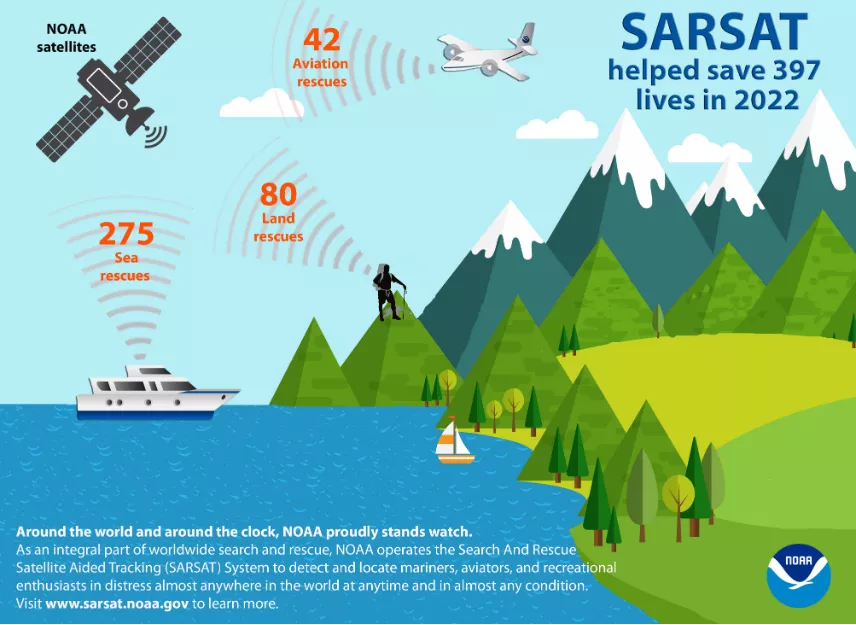Happy SARSAT Beacon Awareness Day (#406Day)!
NOAA’s Search and Rescue Satellite Aided Tracking (SARSAT) system is recognized by emergency responders and related governmental organizations every year on April 6 because it tracks 406 MHz distress signals from transmitters and beacons around the globe.

In 2022 alone, SARSAT helped rescue more than 397 lives in and around the U.S. and its territories. Thus far in 2023, there have been 63 rescues, including 50 people rescued from the sea, four people rescued from aviation incidents, and nine people rescued on land thanks to Personal Locator Beacons (PLBs).
SARSAT is part of COSPAS-SARSAT, an international satellite-based monitoring initiative. Using this system, authorities can locate beacons almost anywhere in the world at any time, and in almost any condition. COSPAS is a Russian acronym for Cosmicheskaya Sisteyama Poiska Avariynich Sudov, which means “Space System for the Search of Vessels in Distress.”
NOAA’s fleet of polar-orbiting and geostationary satellites—such as the JPSS and GOES-R series—is part of the COSPAS-SARSAT network, which uses a network of U.S. and international spacecraft to detect and locate distress signals sent from emergency beacons from aircraft, boats, and handheld Personal Locator Beacons (PLBs) anywhere in the world.
Since its start in 1982, COSPAS-SARSAT has been credited with supporting more than 50,000 rescues worldwide, including more than 10,100 in the U.S. and its surrounding waters.
A few examples of events in 2022 listed below show the power of the SARSAT system during emergencies:
- On Jan. 2, 2022, an emergency locator transmitter was detected near Montrose, Colorado. It activated when an aircraft, with one person onboard, flipped while attempting an emergency landing. The Air Force Rescue Coordination Center received the alert and contacted Fort Worth Hub authorities, who performed a ramp check and provided the coordinates to the airport’s fire chief. The aircraft was located and the pilot was treated for minor injuries.
- On March 18, 2022, a personal locator beacon was detected in Canyonlands National Park, near Moab, Utah, which had been activated by a disoriented hiker. The Air Force Rescue Coordination Center received the alert and contacted the Utah Division of Emergency Management and the San Juan County Sheriff's Office, which dispatched a ground team to the coordinates. The hiker was found and escorted to safety.
- On May 19, 2022, a personal locator beacon was detected south of Atlantic Beach, North Carolina, which had been activated when a sailor fell overboard from an 18-foot catamaran. Coast Guard District 5 received the alert, which correlated with a radio report of a person in the water received by Sector North Carolina. Station Fort Macon launched a rescue boat to the coordinates that recovered the sailor from the water and returned him safely to his vessel.
- On June 26, 2022, an emergency position indicating radio beacon was detected off the coast of Clearwater, Florida. It was activated when a 39-ft fishing boat, with seven people onboard, became disabled after being struck by lightning. Coast Guard District 7 received the alert, launched a helicopter to the location, hoisted the crew without injury, and transported them to Air Station Clearwater.
- On Nov. 5, 2022, an emergency position indicating radio beacon was detected southwest of Key West, Florida, which was activated by the injured captain of a boat that had run aground. Coast Guard District 7 received the alert and launched a rescue boat from Station Key West to the coordinates. The boat arrived, recovered the captain, and transported him to shore where emergency responders were waiting.
By law, beacon owners are required to register their devices online with NOAA. Registration information helps provide better and faster assistance to people in distress, reduces false alarms, and may also indicate what type of help is needed.
For further information about SARSAT and its partner operations, please visit NOAA’s interactive website featuring past rescues through the use of this system throughout North America and the world.
